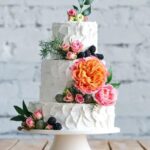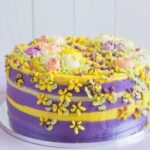Are you wondering how many days in advance can you decorate a cake? Cake decorating is an essential part of creating a beautiful and delicious dessert.
Whether you’re preparing for a special event or simply want to indulge your sweet tooth, understanding the timeline for cake decoration is crucial for success. In this article, we will dive into the factors to consider when decorating a cake in advance, the recommended timeline for decorating, tips for choosing the right techniques, and how to store a decorated cake to maintain its freshness.
When it comes to decorating a cake in advance, there are several factors to consider. You’ll need to take into account the type of icing you’ll be using, the complexity of your design, and how long you want your cake to stay fresh. By understanding these factors, you can better plan and prepare for your cake decorating process.
In addition to understanding the key factors involved in advanced cake decorating, it’s also important to have a clear timeline in mind. How many days before an event can you begin decorating your cake? What techniques should you use to ensure that your decorations stay fresh and beautiful? These are all questions that we will explore in this article as we delve into the world of advanced cake decoration.
Factors to Consider When Decorating a Cake in Advance
When decorating a cake in advance, there are several factors to consider to ensure that the finished product is still fresh, visually appealing, and safe to consume. Here are some key things to keep in mind:
1. Type of Decoration: Depending on the type of decoration you plan to use, you may need to consider how it will hold up over time. Certain decorations, such as fresh fruit or whipped cream, may not have a long shelf life and could spoil if added too far in advance.
2. Storage Conditions: The way you store a decorated cake can greatly impact its freshness and appearance. Factors such as temperature, humidity, and exposure to light can all play a role in how well the cake holds up over time.
3. Shelf Life of Ingredients: It’s important to take into account the shelf life of the ingredients you plan to use for decorating. Certain icings and fillings may have shorter expiration dates, so it’s crucial to use fresh ingredients and be mindful of their longevity.
By taking these factors into consideration, you can better determine how many days in advance you can decorate a cake without compromising its quality or safety.
In order to help guide you through this process, here are some recommended timelines for decorating a cake based on common decorating techniques:
By following these general guidelines and considering the specific factors related to your cake and decorations, you can ensure that your beautifully decorated cake stays fresh and visually appealing for your special occasion.
Recommended Timeline for Decorating a Cake
When it comes to decorating a cake in advance, timing is key. It’s important to plan ahead and consider how many days in advance you can decorate a cake while still maintaining its freshness and quality. The recommended timeline for decorating a cake will depend on several factors, including the type of icing used, the complexity of the design, and storage options.
Factors Affecting Decorating Timeline
Before deciding how many days in advance to decorate a cake, it’s crucial to consider various factors that could impact the timeline. For instance, if you are using a buttercream icing, it can typically be prepared 1-2 days in advance and stored at room temperature.
On the other hand, fondant decorations may need more time to dry and set properly before being placed on the cake. Additionally, complex designs will require more time to execute compared to simpler decorations.
Recommended Timeline
In general, it is safe to start decorating a cake 1-2 days before it will be served. This allows for enough time to complete the decoration without compromising the freshness of the cake. For simple buttercream designs or basic fondant decorations, starting 1 day in advance is often sufficient. However, for more intricate designs or elaborate fondant work, it may be best to start decorating 2 days ahead of time.
Tips for Successful Advanced Decorating
To ensure success when decorating a cake in advance, it’s important to plan carefully and work efficiently. Make sure that your workspace is clean and organized before you begin decorating. Additionally, carefully consider the design elements and techniques you plan to use so that you can allocate your time effectively. Lastly, choose storage options that will help preserve the freshness of the cake without damaging the decorations.
By following these recommendations for when to decorate a cake in advance, you can achieve beautifully decorated cakes without sacrificing their taste or texture. Whether you are creating simple designs or complex masterpieces, proper planning and timing are essential for successful advanced cake decorating.
Tips for Choosing the Right Decorating Techniques for Advanced Decorating
When it comes to advanced cake decorating, choosing the right techniques is crucial for a successful outcome. Whether you’re looking to create elaborate designs or intricate details, the right decorating techniques can make all the difference. Here are some tips for choosing the right decorating techniques for advanced cake decorating:
- Consider the theme: The first step in choosing the right decorating techniques is to consider the theme of the cake. If you’re creating a wedding cake, for example, you may want to incorporate elegant piping and delicate sugar flowers. On the other hand, a child’s birthday cake may lend itself to whimsical fondant decorations and bright colors.
- Assess your skill level: While it’s great to challenge yourself with new techniques, it’s also important to assess your own skill level. If you’re new to cake decorating, you may want to start with simpler techniques before moving on to more advanced methods such as sculpting or airbrushing.
- Explore different mediums: There are numerous mediums available for cake decorating, including fondant, gum paste, royal icing, and buttercream. Each medium has its own unique properties and benefits, so it’s important to explore different options and choose the one that best suits your desired design.
By considering the theme of the cake, assessing your skill level, and exploring different mediums, you can choose the right decorating techniques for advanced cake decorating that will help bring your vision to life.
Remember that practice makes perfect when it comes to mastering new techniques. Don’t be afraid to experiment with different methods and materials until you find what works best for you. With patience and dedication, you can create stunning works of edible art that will impress and delight anyone who sees them – regardless of how many days in advance you choose to decorate your cakes.
How to Store a Decorated Cake to Maintain Freshness
When it comes to decorating a cake in advance, one of the most important factors to consider is how to store the finished product to maintain its freshness. Proper storage can make a significant difference in the taste and appearance of the cake when it is ultimately served. Whether you are using buttercream, fondant, or any other type of icing, knowing how to store a decorated cake is essential.
After decorating a cake in advance, it is crucial to store it properly to ensure its freshness. One option for storing a decorated cake is to keep it in the refrigerator.
Depending on the type of icing used, refrigeration can help prolong the shelf life of the cake and prevent spoilage. However, it’s important to note that certain types of icing may not hold up as well in the refrigerator, so it’s essential to consider this when planning your timeline for decorating.
Another option for storing a decorated cake is at room temperature. Some types of icing, such as fondant, can be stored at room temperature without compromising the freshness of the cake. However, it’s important to ensure that the cake is stored in a cool, dry place away from direct sunlight and heat sources.
Additionally, proper air circulation is crucial for maintaining the quality of the decorated cake. Consider these factors when determining how many days in advance you can decorate a cake and how you will store it until it is served.
Discussing the Different Types of Icing and Their Shelf Life
When it comes to decorating a cake in advance, one of the key factors to consider is the type of icing to use and its shelf life. Different types of icing have varying degrees of stability and longevity, so it’s important to choose the right one based on how far in advance you plan to decorate your cake.
Buttercream Icing
Buttercream icing is a popular choice for cake decorating due to its creamy texture and versatility. When properly stored, buttercream can last for up to two weeks in the refrigerator. However, if you’re planning to decorate a cake several days in advance, it’s best to use a stable buttercream recipe that can hold its shape and texture without melting or becoming too soft.
Fondant
Fondant is another commonly used icing for cake decorating, especially for creating intricate designs and smooth finishes. The shelf life of fondant varies depending on whether it’s store-bought or homemade. Store-bought fondant typically has a longer shelf life and can last for several months when unopened. Once opened, it should be tightly wrapped and stored in an airtight container at room temperature. Homemade fondant has a shorter shelf life and should be used within 2-3 days.
Royal Icing
Royal icing is a hard-drying icing that is often used for creating decorative details such as flowers, borders, and lettering. When stored properly in an airtight container at room temperature, royal icing can last for several weeks. It’s important to keep royal icing covered when not in use to prevent it from drying out.
Understanding the different types of icing and their shelf life is essential when planning to decorate a cake in advance. By choosing the right type of icing and storing it properly, you can ensure that your decorated cake stays fresh and visually appealing until it’s ready to be served.
Potential Risks and Challenges of Decorating a Cake Too Far in Advance
Decorating a cake in advance can be a great way to save time and reduce stress, especially when preparing for a special event or celebration. However, there are some potential risks and challenges that come with decorating a cake too far in advance. It’s important to consider these factors in order to ensure that your cake not only looks great but also tastes fresh and delicious when it’s finally served.
One of the main risks of decorating a cake too early is that the quality of the cake may suffer. Depending on the type of icing and decorations used, the texture and taste of the cake can change over time. For example, fondant decorations may become hard and dry if left on the cake for too long, while buttercream icing could start to lose its smooth consistency.
Another challenge to keep in mind is the potential for the colors of your decorations to fade or bleed over time. If you decorate a cake too many days in advance, especially if it will be stored in a brightly lit area, the colors of any edible decorations or icing may start to lose their vibrancy. This is particularly important for cakes featuring intricate designs or custom images.
In order to mitigate these risks and challenges, it’s crucial to carefully consider how many days in advance you can safely decorate your cake. Factors such as the type of icing and decorations used, as well as storage conditions, should all be taken into account when planning your timeline for decorating a cake.
| Risks & Challenges | Considerations |
|---|---|
| Potential change in texture and taste | Type of icing and decorations used |
| Fading or bleeding colors | Storage conditions and lighting |
Real-Life Examples and Success Stories of Decorating Cakes in Advance
Decorating cakes in advance has become a popular practice among professional bakers and home bakers alike. By preparing decorations ahead of time, decorators can save valuable time and reduce stress when it comes to assembling and decorating the cake. Many successful cake decorators have shared their experiences and tips for decorating cakes in advance, inspiring others to do the same.
One successful example is Mary Smith, a renowned cake decorator who runs her own bakery. Mary shares that she often decorates her cakes two to three days in advance, allowing enough time for the decorations to set properly before adding them to the cake.
This not only saves her time on busy days but also ensures that the decorations stay intact and look flawless when the cake is served. Mary’s dedication to advanced cake decoration has earned her loyal customers who appreciate the attention to detail in her beautifully decorated cakes.
Another success story comes from John Doe, an amateur baker who enjoys creating intricate designs on his homemade cakes. John experimented with decorating a cake five days in advance for a special family event and was thrilled with the results.
His carefully crafted fondant decorations remained fresh and vibrant, impressing his guests with both their appearance and taste. Since then, John has made it a regular practice to decorate his cakes in advance, allowing him to enjoy the decorating process without feeling rushed or pressured.
In addition to these examples, there are countless success stories of individuals who have mastered the art of decorating cakes in advance, proving that with proper planning and technique, it is possible to create stunning and delicious masterpieces well before they are needed for any occasion.
| Decorator | Timeframe for Decorating |
|---|---|
| Mary Smith | 2-3 days in advance |
| John Doe | 5 days in advance |
Conclusion
In conclusion, understanding how many days in advance you can decorate a cake is crucial for achieving the best results. By considering factors such as the type of icing, the design complexity, and the storage options, you can create a beautifully decorated cake that stays fresh and delicious. Following a recommended timeline for decorating a cake will help ensure that you have enough time to perfect your design without compromising its taste and texture.
Choosing the right decorating techniques for advanced cake decorating is also essential. Whether it’s using fondant, buttercream, or royal icing, each has its own advantages and considerations when it comes to preparing in advance. Additionally, knowing how to store a decorated cake properly will help maintain its freshness and appearance until it’s time to be served.
While there are potential risks and challenges associated with decorating a cake too far in advance, with proper planning and execution, it is possible to successfully decorate a cake ahead of time. Real-life examples and success stories of individuals who have mastered advanced cake decorating serve as inspiration for those looking to take their skills to the next level. With patience, practice, and attention to detail, anyone can achieve stunning results when decorating a cake in advance.
Frequently Asked Questions
How Long Will a Decorated Cake Stay Fresh?
The freshness of a decorated cake can vary depending on factors like the type of cake, frosting, and storage conditions. In general, a decorated cake can stay fresh for 2-3 days if stored properly at room temperature.
How Long Before an Event Can You Decorate a Cake?
It is recommended to decorate a cake the day before or the morning of the event. This allows for optimal freshness and ensures that the decorations are at their best when served to guests. Planning ahead is key to avoid last-minute stress.
How Long Should You Leave a Cake Before Decorating?
After baking, it’s important to let the cake cool completely before decorating. This usually takes about 1-2 hours, depending on the size and type of cake. Decorating a warm cake can cause the frosting to melt and lose its shape, so patience is important.

Welcome to my blog about home and family. This blog is a place where I will share my thoughts, ideas, and experiences related to these important topics. I am a stay-at-home mom with two young children. I hope you enjoy reading it! and may find some helpful tips and ideas that will make your home and family life even better!





